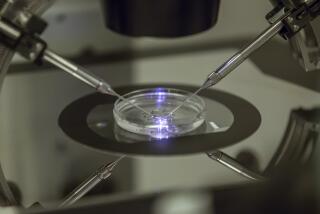Assisted Pregnancies and Risk of Defects Are Linked in Studies
- Share via
In vitro fertilization and other techniques for assisting women in becoming pregnant may carry an additional, unanticipated risk of birth defects and other complications, according to new research.
Babies conceived via in vitro fertilization or the injection of sperm directly into eggs are about twice as likely to be born with a birth defect as babies conceived without artificial assistance, according to one study, published today in the New England Journal of Medicine. Such babies are also more likely to be born with low birth weight, even if the babies are carried to term and are not part of a multiple pregnancy, according to another, independent study also published in the journal.
Even with the higher risk, 90% of babies born as a result of artificial assistance are normal, the researchers on the birth defects study said. But the work raises new questions that infertile couples must weigh in deciding whether to seek high-tech help to become parents, said the authors of the study.
“People need to realize that there are risks associated with the procedures--a whole range of them--and they need to know about those to make informed choices,” said Dr. Jennifer Kurinczuk, lead author of one of the studies and a senior lecturer at the University of Leicester in England.
But fertility experts, responding to the study, said that the reports had shortcomings and that the results are not in keeping with other, earlier reports tracking the fate of babies born by so-called assisted reproductive technology.
“These are a couple more studies in a long list,” said Dr. William Keye, president of the American Society for Reproductive Medicine and director of the division of reproductive endocrinology and infertility at William Beaumont Hospital in Royal Oak, Mich. “They are not the only data we have to fall back on.”
The new studies do not reveal the underlying cause of whatever higher risk exists. One or more of the drugs and methods used in assisted reproductive technology might be responsible, experts said. Alternatively, the heightened risk might be related to whatever problem caused the couple to be infertile, rather than to the methods used to overcome the infertility.
The studies examined large numbers of children conceived by one of two methods. With in vitro fertilization, eggs and sperm are mixed together outside the body, and the fertilized eggs are then implanted back into the mother. In the newer technique known as intracytoplasmic sperm injection, an individual sperm cell is injected into an egg, which is then implanted.
In vitro fertilization has been used since the late 1970s; intracytoplasmic injection was pioneered in the 1990s and is mostly used in cases of severe male infertility.
Kurinczuk and her colleagues collected data from birth registries in Western Australia for 1993 through 1997. They compared the rates of birth defects in 1,138 babies conceived using assisted reproduction with that of 4,000 naturally conceived infants in the same area.
The authors found that rates of birth defects--ranging from life-threatening heart defects to milder abnormalities such as hand deformities--were doubled in the artificially conceived group. Rates of chromosomal defects were also heightened in this group.
The second study was conducted by a team led by Laura A. Schieve, an epidemiologist at the Centers for Disease Control and Prevention. The team compared the birth weights of 42,463 U.S. infants born in 1996 and 1997 with assisted reproductive technology to more than 3 million U.S. infants born in 1997.
The researchers found that babies conceived by assisted reproductive technology were twice as likely to be of low birth weight even when they were not sharing the womb with another fetus and were carried to term.
Statistical analysis suggested that the results couldn’t be explained by the somewhat older age of mothers undergoing fertility treatments and the greater likelihood that this was their first pregnancy, Schieve said. She and her colleagues suspect that something about the treatment is causing the heightened risk.
“But we are unable to separate what specific treatments may be related to this,” she said.
As a group, babies with low birth rates are at higher risk for neurological problems and developmental delays, and those with very low birth weights are at especially heightened risk, said Dr. Michael E. Speer, professor of pediatrics at the Baylor College of Medicine in Houston. Thus the results are of concern, he said.
But there are many unanswered questions in the studies, said Keye and Dr. Jamie Grifo, president of the Society for Assisted Reproductive Technology and professor of obstetrics and gynecology at New York University School of Medicine.
It is unclear, for example, how much smaller the babies were in the birth weight study and whether these lowered weights were severe enough to create problems.
“I am going to tell my patients what I always tell my patients--we don’t know the impact and risk one undergoes with these procedures,” Grifo said. “But for the next six months, I am going to go nuts with every patient coming in with these articles. They should be discussed. But we have to be careful about how we present these kinds of articles because they can alarm people and create anxiety where maybe there shouldn’t be.”






